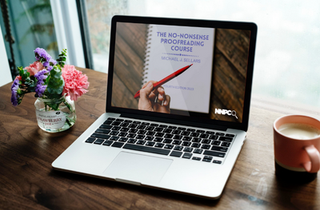|
For the remainder of August only, I will be offering The No-Nonsense Proofreading Course for the discounted price of just £24.99. That's a £5 reduction.
In the interest of fairness, I'll be contacting everyone who bought the eBook at the undiscounted price of £29.99 and issuing them a £5 partial refund. Be patient, this may take a few days. Thank you. Enjoy the summer!
0 Comments
 What do I mean by 'commercial proofreading'? It's true that all (or at least most) proofreading is commercial in nature. Even if you're proofreading an experimental novel in which the main character is a particle of grit trapped beneath Bruce Springsteen's fingernail, there will still be a publication date to meet and a budget that must not be exceeded. However, in the case of Grit: a Novel, the book is very much at the centre of things. In a commercial proofreading environment, the literature (or 'collateral' in marketing parlance) is very likely to be a component part of a large and complex money-making enterprise. I've heard some proofreaders describe commercial proofreading as 'hard proofreading' and non-commercial or literary proofreading as 'soft proofreading' or, in one particularly uncharitable instance, as 'fluffy proofreading'. Examples of commercial proofreading environments include the marketing, internal communications or documentation departments of:
In other words, pretty much any large organisation intent upon making money. An Example of Commercial Proofreading. As I've mentioned in my proofreading course, I worked for thirteen years in various roles in a well-known UK mail-order catalogue business that now operates predominantly online. In all of these roles, proofreading was a core discipline. Latterly in this organisation, I was responsible for the hiring, training, coordination and development of a team of proofreaders. The principle diet of the proofreaders here was, unsurprisingly, mail order catalogue pages. These pages were packed with products. The purpose of these pages was to sell these products to the customer by providing all of the information necessary to make a purchasing decision. The success (and, indeed, the survival) of the business was entirely dependent upon the ability of these pages to generate sales. Each catalogue contained over 1,000 pages. We produced two of these catalogues each year plus numerous variants and a range of accompanying brochures and leaflets. In total, tens of thousands of pages were moving through the operation annually. Although the quality of each catalogue was very important, it was absolutely vital that the catalogue was in the hands of customers to coincide with an expensive launch campaign and that all the necessary product was in there, accurately represented. In the commercial proofreading environment, some things matter more than others. In a fluffy... sorry, literary proofreading situation, you are in service to the writer and his or her editor. The quality of the book is central. Indeed, in a literary publishing environment, the quality of the book is commercially critical because the book is the product. Sloppily produced books will receive poor reviews and are likely to leave the reader unimpressed. Encountering an error in an otherwise good book can jolt the reader out of the narrative, destroying in one fell swoop all the author's hard work to induce a state of suspended disbelief in the reader. In a commercial proofreading environment, the collateral is a tool that serves the business, not a product in and of itself. This isn't to say quality doesn't matter. It very much does matter. However, this has to be balanced against other crucial factors, and timing is everything. The time for pedantry is at the beginning. Most modern businesses operate on the principle of 'get it right first time'. Commonly employed business philosophies such as Six Sigma and Lean Excellence teach that rework is a 'non-value-added activity'. This means it isn't something the customer would be willing to pay for. Think about it; if you knew that when you bought a product, the cost of the producer's errors and subsequent remedial actions were built-in to the cost of the product, you wouldn't be best pleased! If you have the time, watch the video below, which will give you some insight into the importance of operational efficiency in any business. So, in a get-it-right-first-time environment, the first read is all-important. This is the time to think about aesthetics, smoothing off any rough edges and pandering to the inner pedant. Because the first read will generate the largest number of corrections, capacity planning managers are likely to allocate more time to this phase than they are to any later reads.
Once that first read proof is initialled and leaves your inky fingers, the inner pedant must be temporarily mothballed. It's painful, I know. Just make sure you leave an air-hole and, don't worry, the smell of naphthalene fades after a few days. With the little nitpicker out of the way, it's time to clear your head and start thinking in purely commercial terms. From this point on, you should be questioning every correction you request because everything you do from this point on costs money. You'll be surprised just how much money. The cost of pedantry in a commercial proofreading environment. The following is based on true events. Names have been changed to protect innocent and guilty alike. Warning: some proofreaders may find the following report disturbing. The first reads of the white goods pages of our catalogue had been completed a couple of weeks ago. Since then, the pages have been with the graphic designers having images and promotional devices added. Now designated 'artworks' (previously, they'd been designated 'layouts') they return to the proofreaders, to make sure nothing has gone awry with the text during artwork creation. At this stage, the proofreader is simply meant to check that everything is still as it was and none of the text has been concealed by an image or misplaced by a 'wraparound' instruction on an image. In some cases, the designer may have reordered the product on the page, necessitating the reordering of the text. Very little time is allocated for this stage of the proofreading. In a moment of what can only be described as abject madness, one of my proofreaders decides to subject the pages to a little more scrutiny than he ought to. He notices that there is some inconsistency in the way the dimensions of the various fridges, washing machines, tumble dryers and dishwashers are presented. Sometimes, there is a space between values and increments and sometimes there is not. He sets to work with his red pen, marks-up the proofs (all the proofs) and puts them in the rack from where the page make-up artists pick up their work. You may think this is an example of diligence. And, to be fair, it is. But it is also a commercially foolish decision. I want you to imagine that each of the bullet points below instead of being a simple black dot is a skull. With a dagger through it. On fire. Chewing on a stick of dynamite like it's a Cuban cigar.
However, this isn't the worst of it.
As anyone who has ever worked in a production environment will know, once you're behind schedule, particularly if you're already working to a tight, demanding schedule, it's very difficult to make-up the time and get things back on target. Unless you resort to overtime. Which is what we did.
What the proofreader should have done. Once he'd noticed the inconsistency, he should have spoken to his Operations Manager, which, in this case, was me. I could have checked the schedule to see whether we were ahead and had the capacity to carry out the corrections. Even if I didn't think we had the capacity to act on the proofreader's concerns there and then, I could have made a note and the corrections could have been carried out later if the opportunity arose. But isn't consistency important? Yes, of course it is. But it was far more important that our costs were controlled and that our catalogue was delivered to the customer on time. The likelihood of a customer noticing the inconsistency is vanishingly remote. Remember, a customer doesn't actually read a catalogue; they browse, flicking back and forth from page to page, then home-in on chunks of relevant information. They don't read in the same linear, focused fashion that a proofreader does or even in the same way that you might read a magazine or a newspaper. So, what is important enough to risk additional costs If the error you spot is going to be in anyway commercially damaging or problematic, it will need to be addressed. For example: 1. An incorrect price Even if a price is out by a few pennies, it can have serious consequences for the bottom line. A price that is accidentally inflated will render a product uncompetitive resulting in low or, in exceptional cases, no sales. A price that is accidentally lowered will affect the projected margin for that product. Either way, somebody will be held accountable. 2. Inaccurate information If, in our example above, the proofreader had noticed that the actual measurements were wrong then there would have been genuine cause for alarm. If a customer purchases a freezer with a view to installing it in a particular location and the dimensions he is given are wrong then the freezer isn't going to fit. Quite naturally, the customer is going to return the product. Returns are especially costly for a retail business because the business itself is, quite rightly, expected to absorb the cost of return shipping. So not only is the sale now null and void, with a full refund having to be issued, there is also the additional cost of return shipping. It's a lose-lose situation. 3. Legal issues Careful attention must be paid to terms and conditions, and anything else which in essence forms part of a contract with the customer. Mistakes here can result in litigation, which can be extraordinarily expensive for the business. 4. Embarrassing errors Some errors will make the business appear foolish or just plain dumb. A few years ago, this wouldn't necessarily have been a big deal but now, in this age of powerful social media, such errors can 'go viral' and become a self-perpetuating negative publicity campaign. For example, the retailer I worked for produced a lingerie page in which a black model wearing a black bra was accompanied by the caption, "Also Available in White". Obviously, the caption referred to the garment she was wearing but a large number of complaints were received accusing the company of gross cultural insensitivity. And, to be fair, they had a point. And if not cultural insensitivity, then certainly a degree of thoughtlessness. Luckily for the company, this was in a time when social media was a fledgling phenomena and so it didn't get out of hand. Although these kinds of cringe-inducing faux pas are unlikely to result in any immediate haemorrhaging of funds, they can reduce the business's credibility in the eyes the public, which will almost certainly have a detrimental effect on the bottom line in the long term. Multi-Skilling is Key in Commercial Proofreading Environments. In order to ensure the longevity of your proofreading career, it is wise to acquire additional skills. In particular, you'll need to learn how to carry out the kind of amends you would normally request. From a production manager's point of view this reduces the chances of a large volume of relatively small corrections bottlenecking on the department, with page make-up people overwhelmed and proofreaders scratching around for work. This will mean learning the basics of the likes of Adobe InDesign, Quark Xpress or possibly even Adobe Illustrator. Once appropriately skilled, the production manager (or studio manager, publications manager etc) can relieve any bottlenecks by moving resource from proofreading to corrections. In this situation, however, it is very important that you resist the urge to carry out your own corrections. Once you've got to grips with simple amends, try to increase your skill level with a view to actually being able to create pages from scratch. At this point, you will be an extremely valuable asset to any business. Conclusion In commercial proofreading, the literature being read is not the end product, it is a means of communicating with a customer in order to convince them to make a purchase. Everything you do as a proofreader in this environment must serve this purpose as well as supporting the efficiency of the business itself. Although the aesthetic quality and consistency of the literature is important, it must be weighed against a whole raft of other commercial concerns. This blog post is by no means exhaustive and I'd really like to hear from other commercial proofreaders about their experiences. If you have any questions, feel free to put them to me using the comments form below. Thanks for your time. |
Details
Testimonials
“I am one of those many fools who paid a huge amount of money for a useless course. This book... has opened so many doors for me. I now look on Mike as my mentor as I embark on a career. Thank you Mike.” Emma Steel, Proofreader and International Structural Editor. “ I thoroughly enjoyed the course and am so glad that I decided to take it... the whole experience was invaluable. My proofreading service is now well established and your course played no small part in getting it off the ground.” Hache L. Jones, Proofreader. “I'd just like to thank you first of all for writing such a great, straight forward eBook, and then going above and beyond what I would even expect as a customer by providing us, completely free of charge, updated versions months later!” Rachel Gee, Trainee Proofreader. “What can I say? Worth every penny and then some! God Bless! This a fabulous course.” Teresa Richardson, Proofreader. “As someone who has effectively been proofreading for thirty years, I found Mike’s No-Nonsense Proofreading Course an invaluable introduction and a very useful practical guide to many aspects of this discipline. I can wholeheartedly recommend it as the ideal starting point, and much more besides.” Jeremy Meehan, Proofreader. Blog AuthorMy name's Mike Sellars and I'm an experienced proofreader and the author of The No-Nonsense Proofreading Course. Click here to find out more about me. The No-Nonsense Proofreading CourseA Fraction of the Cost of Other Proofreading Courses NOTE: Stock is currently limited to 10 per day, so we can continue to deliver exceptional after-sales service, answer queries and provide open-door support. Credit card and PayPal payments accepted. “As someone who has been proofreading for 30 years, I found Mike’s course an invaluable introduction and a very useful practical guide to many aspects of the discipline. I can wholeheartedly recommend it.” Jeremy Meehan, Proofreader. Still want to find out more? Click here. Proofreading Categories
All
Proofreading Archives
July 2024
|

 RSS Feed
RSS Feed
